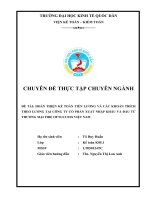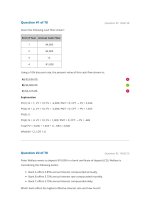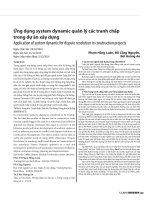Masters thesis of engineering topological design of porous titanium alloy scaffolds for additive manufacturing of orthopaedic implant applications
Bạn đang xem bản rút gọn của tài liệu. Xem và tải ngay bản đầy đủ của tài liệu tại đây (1.09 MB, 109 trang )
Topological design of porous titanium alloy scaffolds for additive
manufacturing of orthopaedic implant applications
A thesis submitted in fulfilment of the requirements for the degree of
Master of Engineering
Li Yuan
Bachelor of Engineering, RMIT University
School of Engineering
College of Science, Technology, Engineering and Maths
RMIT University
August 2020
Declaration
I certify that except where due acknowledgement has been made, the work is that of the author
alone; the work has not been submitted previously, in whole or in part, to qualify for any other
academic award; the content of the thesis is the result of work which has been carried out since the
official commencement date of the approved research program; any editorial work, paid or unpaid,
carried out by a third party is acknowledged; and, ethics procedures and guidelines have been
followed.
I acknowledge the support I have received for my research through the provision of an Australian
Government Research Training Program Scholarship.
Li Yuan
4th August, 2020
1
Acknowledgements
I would first like to thank my supervisors, Professor Songlin Ding and Distinguished Professor
Cuie Wen for their support, assistance, supervision, and guidance throughout my thesis. Without
their help, this would not have been possible. Additionally, I would like to thank Dr Guangxian Li
for his kind assistance in the analysis and interpretation of data relating to the project. During the
two years, I have learnt a lot under their guidance, and their expertise and advice have been
enormously valuable throughout my research program.
My particularly thanks go to my parents and my wife for their understanding and support.
2
Table of Contents
Declaration ................................................................................................................1
Acknowledgements ....................................................................................................2
List of Figures ...........................................................................................................6
Nomenclature ..........................................................................................................10
Abstract ....................................................................................................................13
Chapter 1 Introduction ...........................................................................................15
1.1 Background ........................................................................................................ 15
1.2 Research Scopes................................................................................................. 18
1.3 Research questions ............................................................................................. 18
1.4 Research objectives, innovations and contributions .......................................... 19
1.5 Thesis outline ..................................................................................................... 21
1.6 Summary ............................................................................................................ 23
Chapter 2 Literature Review ...................................................................................24
2.1 Bio-related properties......................................................................................... 24
2.1.1 Non-toxicity and biocompatibility .......................................................................................................................... 25
3
2.1.2 Biomechanical properties .......................................................................................................................................... 26
2.1.3 Biodegradability for temporary implant materials ............................................................................................ 27
2.2 Porous structure and porosity of implant materials ........................................... 29
2.2.1 Porous structure with appropriate pore size and porosity ............................................................................ 30
2.2.2 Effect of porosity on biocompatibility ................................................................................................................... 30
2.2.3 Effect of porosity on mechanical properties ....................................................................................................... 33
2.2.4 Effect of porosity on biodegradability ................................................................................................................... 35
2.3 An overview of additive manufacturing (AM) .................................................. 36
2.3.1 AM procedures .............................................................................................................................................................. 40
2.3.2 Metallic AM techniques .............................................................................................................................................. 41
2.3.3 Other AM techniques .................................................................................................................................................. 43
2.3.4 SLS and SLM ................................................................................................................................................................... 44
2.3.5 EBM.................................................................................................................................................................................... 51
2.3.6 Metallic biomaterials fabricated by AM for implant applications ................................................................ 55
2.4 Summary ............................................................................................................ 57
Chapter 3 Structure design and modelling ............................................................58
3. 1 Triply periodic minimal surface (TPMS) structures ......................................... 58
3.2 Gyroid structure 3D modelling and procedures ................................................. 67
3.3 Summary ............................................................................................................ 73
Chapter 4 Structure analysis ..................................................................................74
4
4.1 Models preparation for finite element analysis and basic theories .................... 74
4.2 Young’s modulus analysis ................................................................................. 79
4.3 Further analysis of gyroid scaffold and introduced cubic .................................. 85
4.4 Summary ............................................................................................................ 89
Chapter 5 Conclusions ............................................................................................90
References................................................................................................................93
Appendices .............................................................................................................108
5
List of Figures
Figure 1.1 Orthopedic implants in a knee replacement surgery .................................................. 16
Figure 1.2 The structure of the thesis ........................................................................................... 23
Figure 2.1 Magnesium scaffold structure for biomedical application ......................................... 26
Figure 2.2 Cross-section of human femur with porous structure (trabecular & cortical bone) ... 29
Figure 2.3 Ti scaffolds with 70% porosity and different ranges of pore sizes [41] ..................... 32
Figure 2.4 Scheme of a SLM machine [84] ................................................................................. 45
Figure 2.5 SEM images of Ti6Al4V gyroid lattice surfaces fabricated by SLM: (a) and (b) asbuilt, (c) and (d) after post treatments (heat treatment and sandblasting) [88]............... 48
Figure 2.6 CP-Ti scaffolds fabricated by different AM methods (a) SLM (b) EBM .................. 50
Figure 2.7 SEM images of Tie6Ale4V gyroid lattices surfaces fabricated by EBM: (a) as-built,
(b) after post treatment of ceramic blasting [20]. ........................................................... 52
Figure 2.8 (a) Schematic of an EBM machine and (b) its processing chamber [91,92] .............. 54
6
Figure 3.1 Primitive TPMS unit cell and Primitive TPMS structure ........................................... 59
Figure 3.2 Gyroid unit cell with ± 0.6 offset ............................................................................... 60
Figure 3.3 3D CAD gyroid unit cells: (a) 3 mm sheet solid gyroid unit cell with 0.3 mm offset
thickness and (b) 3 mm network solid gyroid unit cell at 50% volume fraction ............ 65
Figure 3.4 A block of a 3D CAD gyroid scaffold in different views (constituted by 3 mm
network solid gyroid unit cell) ........................................................................................ 66
Figure 3.5 (a) a single unit gyroid surface covered by a cubic block (b) a single cell of network
based gyroid .................................................................................................................... 69
Figure 3.6 Gyroid surfaces and network-based on gyroid unit cell with different offset (α)
values: (a) a 3 mm network-based gyroid structure in an 3 × 3 × 3 mm cubic; (b-1)
gyroid surface without offset, (b-2) network-based gyroid unit cell without offset, (c-1)
g ...................................................................................................................................... 71
Figure 3.7 Schematic of a normal pore and a deformed pore ...................................................... 73
Figure 4.1 The scaffold structure in .stl format ind different views (a) top view (b) front view (c)
3-dimensional view (d) righ-side view ........................................................................... 77
Figure 4.2 Cross-section of gyroid scaffold in .stl format ........................................................... 78
7
Figure 4.3 Cross-section of single unit gyroid (fulfilled) ............................................................ 79
Figure 4.4 (a) 3mm gyroid unit cell under compression (b) 3mm gyroid unit cell under under
tension (c) the Ti scaffold structure under compression (d) the Ti scaffold structure
under tension ................................................................................................................... 81
Figure 4.5 3 mm gyroid unit cell compression ............................................................................ 83
Figure 4.6 1×2×3 units compression ............................................................................................ 84
Figure 4.7 3 mm gyroid unit cell tension ..................................................................................... 84
Figure 4.8 2×2×3 units compression ............................................................................................ 85
Figure 4.9 3 mm unit cubic cell modelling and simulation (b) 1×2×3 units cubic scaffold
modelling and (c) meshing (d) simulative results of cubic unit cell (e) simulative results
of cubic unit scaffold ...................................................................................................... 87
Figure 4.10 Computational result of 3mm gyroid scaffold under compression .......................... 88
Figure 4.11 Computational result of 3mm cubic scaffold under compression ............................ 89
8
List of Tables
Table 1 Summary of different AM methods…………………………………………38
Table 2 Features of SLM and EBM in comparison………...……………………………49
Table 3 Summary of different as-built Ti-6Al-4V TPMS architectures .……………63
Table 4 Basic material mechanical property (Ti6Al4V) setup in NX Nastran………….…79
9
Nomenclature
AM
Additive manufacturing;
TPMS
Triply Periodic Minimal Surfaces;
SLM
Selective laser melting;
P
Porosity;
ρstructure
Density of the bulk alloy;
ρmaterial
Density of the porous structure;
σpl
Plastic collapse strength;
E
Elastic modulus of the porous material;
ρ
Density of the porous material;
ρs
Density of the solid material;
10
σys
Yeild strength of the solid material;
Es
Elastic modulus of the solid material;
r
Corrosion ratio;
M1
The object mass;
M2
The object mass after corrosion;
ti
Immersion time;
FDM
Fused deposition modelling;
PBF
Powder bed fusion;
SL
Stereolithography;
DED
Direct energy deposition;
LOM
Laminated object manufacturing;
11
SLS
Selective laser sintering;
EBM
Electron beam melting;
α
Offset value;
L
The variable determining the size of unit cell's edge
length;
12
Abstract
With the development of material science and biological technology, new biocompatible materials
such as titanium alloys are gradually used more and more in the manufacturing of medical implants
to replace conventional materials including stainless steel and Co-Cr alloys. These new materials
showed excellent performances in the load-bearing implant applications and can be used as a
replacement of bones and joints in clinical surgeries. Nowadays, with the assistance of additive
manufacturing technology, medical implants with complicated topological structures and shapes
which were previously not manufacturable with conventional manufacturing approaches are
designed and fabricated. It not only significantly increases the feasibility of bone joint replacement
by biomedical materials but also has dramatic influences on the development of modern medicine.
However, the design of new implants is a challenging task in order to ensure the high quality of
implants to avert both biocompatible and mechanical risks. Firstly, when designing the implants,
the properties of the biomaterials should be considered, including the physical properties (e.g.
density, elastic modulus) and the chemical properties (e.g. biocompatibility). Secondly, the
potential negative effects on bone defect treatment should be examined to avoid issues caused by
any inappropriate mechanical behaviour of materials. Finally, and more importantly, due to the
mismatch of elastic modulus between natural bone and the implants, stress shielding which is
another major mechanical issue of metallic implants has to be minimized. A large mismatch of
elastic modulus may lead to bone atrophy and implant loosening.
13
A new porous titanium scaffold which exhibits an architecture mimicking that of human bones
was developed in this research for the application of implants. The scaffold will be constructed by
multiple unit cell sizes, which enables adjusting the elastic modulus to meet different requirements.
The porous structure can provide the necessary support for cells to proliferate and maintain their
differentiated functions, and their structure defines the ultimate shape of the new bone created
during growth processes.
A comprehensive literature review was conducted by summarizing the state-of-the-art
technologies and critical issues associated with the results of the biomedical porous material
fabricated with different methods. Different triply periodic minimal surface (TPMS) structures and
their characteristics were investigated, especially for gyroid structures. Three-dimensional
modelling of gyroid structure (unit cell and small scaffold) were conducted for further analysis of
the design. To address the issue of the higher elastic modulus of Ti, a 3mm Network-based gyroid
unit cell and small scaled scaffolds previous designed were analysed in regard to the mechanical
behaviours. Specifically, the models were optimized for evaluating the Young’ modules, in order
to meet the certain requirement. In addition, a 3mm cubic open-cellular structure was developed
as the comparison group in this simulation.
Keywords: Metal implant design; Additive manufacturing; Porosity; Stress shielding; TPMS
structures; Gyroid
14
Chapter 1 Introduction
1.1 Background
Bone is an anisotropic connective tissue consisting of hydroxyapatite, collagen and water. It
provides frames for skeleton structural stability, protects vital organs and specialized tissues, and
supports the mechanical actions of soft tissues. Bones have excellent regenerative properties and
self-healing abilities for the body to recover from physical injury. However, bone's regenerative
ability becomes weaker when people become older; and if suffered from a serious trauma or a
systemic bone disease, bones may be found extremely difficult to recover their self-healing
functions.
The needs for orthopaedic implants have dramatically increased in the last two decades. Patients
are expecting treatments that allow them to maintain their daily activities and quality of life. Taking
Knee replacement as an example (Figure 1.1), the rates of total knee replacement (TKR) have been
significantly increased from 1991 to 2006 [1]. In the US, patients spent over US$9 billion on the
total knee arthroplasty (TKA) in 2009 and the major demand of TKA was in group aged 45–64
years [2]. The value of the biomaterials market was US$94.1 billion in 2012, and increased to
US$134.3 billion in 2017 worldwide [3]. This rapid increase in the biomaterials market has to a
certain extent brought benefits for the development of bone tissue engineering (BTE).
15
Figure 1.1 Orthopedic implants in a knee replacement surgery [4]
Advanced biomaterials, fabrication methods, and the structural designs of medical devices have
been greatly improved in the last twenty years. Materials for medical applications need to meet
several criteria, and designed implants should morphologically mimic bone structure and support
bone
tissue
formation
(osteogenesis).
Biocompatibility,
mechanical
properties,
and
biodegradability are the fundamental elements that must be considered. The structure of bone is
almost completely constituted by hydroxyapatite crystal, a mineral form of calcium apatite, within
an organic matrix of collagen [4]. Of this collagen, 95% is type I, providing the structural integrity
for connective tissues in bones, tendons, and ligaments. The remaining 5% of the bone is a
combination of proteoglycans and numerous non-collagenous proteins. An effective implant will
be accepted by the human body and function properly. An inferior orthopaedic device can trigger
serious issues in patients. In Australia, the Therapeutic Goods Administration (TGA) provides
16
regulations for medical devices, such as Australian regulatory guidelines for medical devices
(ARGMD), which provide guidance to assist the manufacturers and sponsors of medical devices
in meeting the regulatory requirements for legally supplying a medical device in Australia [5,6].
Metal-AM fabrication has been extensively explored in the last decade and this technology has
been successfully used in the biomedical field. 3D printed physical models can provide a detailed
visualization of clinic cases before surgery, which is a practical approach for surgery planning and
accurate diagnosis. Surgeons and medical doctors can simulate surgery processes on 3D printed
models to examine the outcomes of the surgery and find any potential surgical risk and failing
factors [29, 30]. More importantly, AM technology can produce customized implants for bone
replacement and fixation. Since the current implant structure design becomes increasingly
complex to meet different requirements (e.g., interconnected porous TPMS scaffold), it could be
challenging to manufacture such a metallic implant via conventional fabrication methods such as
casting, forging, milling, and turning. This technology is also capable of fabricating complex
porous structures with both micro and macro porosity. Due to the high solidification rate of AM
techniques, AM-produced implants may exhibit high strength [31].
The choice of implant materials should meet the requirements of the specific implant to ensure
nontoxicity and biocompatibility, a porous structure with appropriate pore size and porosity,
suitable biomechanical properties including appropriate elastic modulus and high strength, and
also biodegradability for temporary implant materials.
17
1.2 Research Scopes
The scope of this research is to investigate the mechanical behaviours of alloyed Ti scaffolds
fabricated by selective laser melting (that is, a powder bed fusion technique) with different
geometries. The structure of the scaffolds will be designed in 3D models and their mechanical
properties will be analysed with finite element method. The size effect of the cells on the
mechanical behaviour of different scaffolds is going to be investigated, which will be the principle
for the optimization of the structure design of scaffolds. The fabrication process of the scaffolds
will be analysed, and the effects of different parameters on the quality and performance of the
scaffolds after sintering will be investigated.
1.3 Research questions
1) Which TPMS geometric structure provides acceptable mechanical properties in scaffold
design?
TPMS describes a periodically infinite structure along three independent directions with zero
mean curvature of the surface (the concave and convex curvatures are symmetrical at all
points. Porous architectures with TPMS topology are constructed by repeating elements with
the minimum possible area (unit cells). TPMS is also defined by implicit functions and can be
distinguished by curved surfaces even at the junction of struts. In this thesis, the influence of
TPMS structure on the mechanical properties of Ti scaffolds is investigated.
18
2) What are the mechanical property differences among the scaffolds with unit cell size of
2 mm, 2.5 mm, 3 mm and mixed sizes?
The main properties of the Ti scaffolds are Young’s modulus and the compressive strength
which strongly affected by the structure of the scaffolds. The proper cell sizes for Ti scaffolds
are 2 mm, 2.5 mm and 3mm. In this thesis, the size effect of the cells was investigated via FE
analysis and experiment. The properties of even-sized scaffolds and mix-sized scaffolds are
compared.
3) What are the possible reasons that cause the mechanical property differences between
the SLM-built and the designed models?
This thesis comprehensively analyses the reasons that affects the mechanical properties
including the size of cells, the geometry of the cells and the machining parameters used in
laser-based AM.
1.4 Research objectives, innovations and contributions
Based on the scopes and questions of the research, the overall objective is to investigate different
biomedical Ti scaffolds fabricated by selective laser melting. The detailed objectives of this study
are:
•
To use computational modelling and analysis to design porous scaffold structures.
19
•
To build up different TPMS (Triply Periodic Minimal Surfaces) geometries with
different unit cell sizes (unit cell size 2mm, 2.5mm, 3mm and mixed sizes).
•
To analyse the mechanical properties of the SLM-manufactured scaffold samples.
•
To compare and analyse the mechanical property of the designed models.
The innovation of this research is to find out a new approach for scaffold structure design, in
regards to the mechanical properties. The Young’s modulus of designed scaffold should be in the
range of 7 and 30 GPa, to eliminate the mechanical risks.
Undertaking this research is beneficial for the development of additive manufacturing (AM) in the
biomedical filed. AM technology promises to produce complex structures with bio-mimic features,
which is able to address the limitations of conventional manufacturing methods. As mentioned
above, an implant needs to exhibit an appropriate elastic modulus to match that of natural bone.
Mechanical damages or failures of implants caused by stress shielding should be avoided.
Recently, researchers pay attentions to open cellular structures, which possess low elastic modulus
due to the introduction of porosity into metal materials. The strut-based, skeletal-TPMS and sheetTPMS porous structures have been extensively investigated. However, most of the research
focused on single unit cell size analysis such as 2 mm gyroid, 3 mm diamond, etc., where the
elastic modulus is at a fixed level of the scaffold. In this research, the scaffold will be constructed
by multiple unit cell sizes, which enables adjusting the elastic modulus to meet different
requirements.
20
1.5 Thesis outline
The thesis consists of five chapters which aim to investigate the mechanical properties and
fabricating processes of different biomedical Ti scaffolds, with the structure presented in Figure
1.2.
Chapter 1 is a generalized introduction to the content of the thesis, including the background,
scopes and objectives of the research.
In Chapter 2, a comprehensive literature review is presented. Reading related articles and technical
papers is fundamental base for this research, which provides with solid knowledge to achieve the
goals. Titanium alloys, 3D printing technology and TPMS structures were the major research areas.
In addition, literature review is a good way for preparation of upcoming experiments.
Chapter 3 presents the design and fabrication of the Ti scaffolds. Firstly, the computational
modelling and simulation was the preparation step for 3D printing. The mechanical properties of
the as-designed models were investigated under numerical analysis (Finite element analysis) of
mechanical properties to compare with as-build models. K3Dsurf will be applied initially to
generate the unit cell of the desired TPMS models. Then, the generated models were imported into
Rhinoceros, Netfabb and 3ds Max for creation and optimization of 3D printing objects. Once the
design objects have been made by CAD software applications, the files have to be saved as STL
format for further printing purposes. In laboratory sessions, the generated STL files was printed
21
out by SLM, which is one of laser-based additive manufacturing methods, by using the laser beam
to scan the powder bed at predefined speed and locations. It is capable for metal fabrication with
complex geometry, such as open cellular structures. Printing material will be Ti-6Al-4V.
In Chapter 4, the mechanical properties of the fabricated Ti scaffolds were analyzed. The
microstructures of all of the experimental objects were recorded and observed by the Scanning
Electron Microscopy (SEM). Then, compression test will be conducted to measure and evaluate
mechanical properties of each object throughout this process. After compression test, the result
will be analysed and compared with the Young’s modulus of cortical bones. The designed models
have to be in the range of 7 and 30 GPa to protect patients from mechanical risks. In addition, the
result can be also used to compare with other researchers’ results. If the results are different, try to
figure out the possible reasons.
Finally, a conclusion including the findings and main contributions from this research, as well as
future works related to this research were presented in Chapter 5.
22
Figure 1.2 The structure of the thesis
1.6 Summary
This chapter presents the background, research scopes, research questions, research objectives,
innovations and outline of the thesis.
23
Chapter 2 Literature Review
This chapter presents a review of the current technology and issues associated with the results of
the biomedical porous material fabricated with different methods. The review covers three main
aspects:
1) The review of fundamental bio-related properties including the non-toxicity and biocompatibility, bio-mechanical properties and the bio-degradability of the porous materials.
2) The review of the characteristics of porous structure, and the effects of different porous
structures on bio-compatibility, mechanical properties and bio-degradability.
3) The review of additive manufacturing (AM), and different AM methods on the fabrication of
biomedical porous materials.
2.1 Bio-related properties
Materials for medical applications need to meet several criteria, and designed implants should
morphologically mimic bone structure and support bone tissue formation (osteogenesis).
Biocompatibility, mechanical properties, and biodegradability are the fundamental elements that
must be considered.
24





